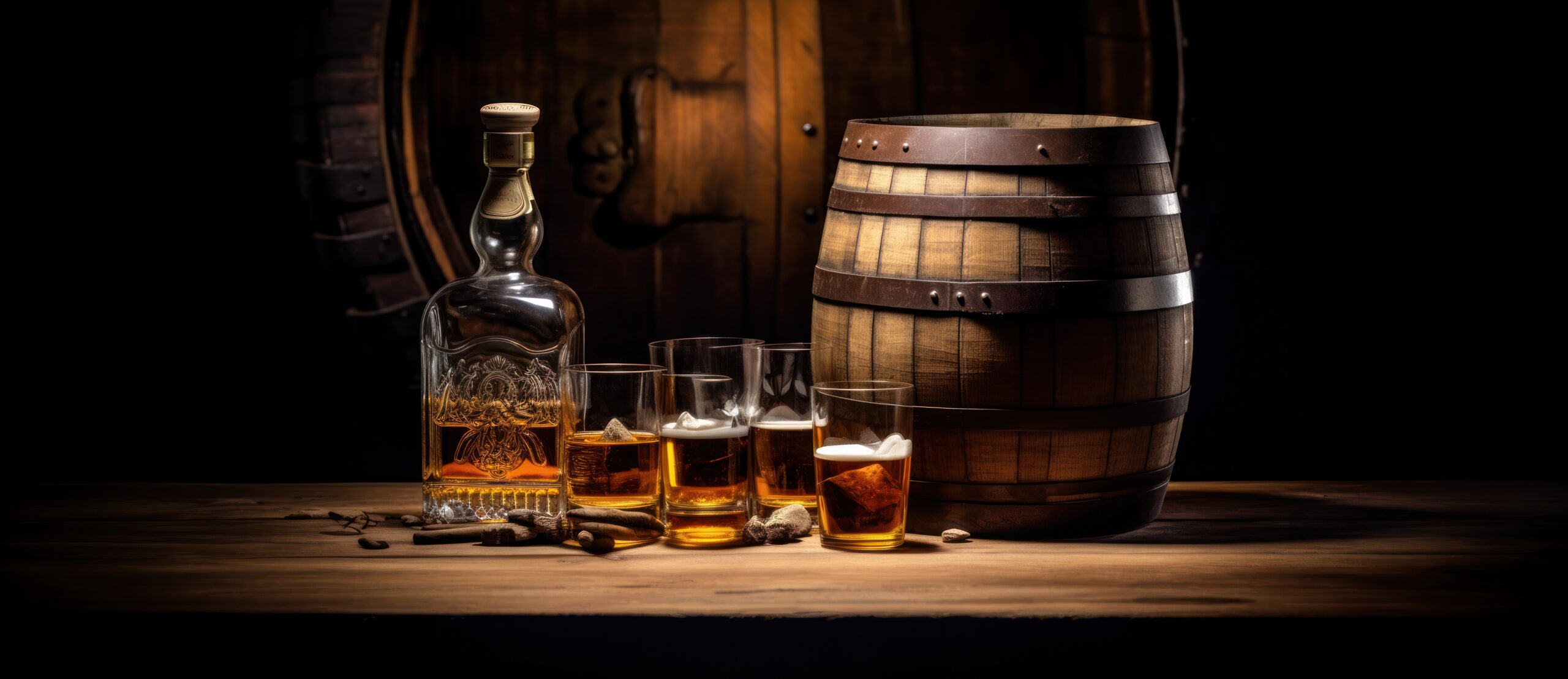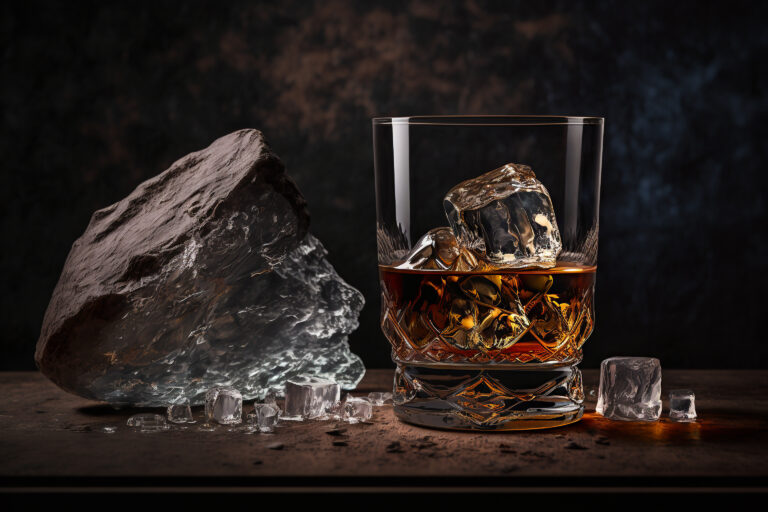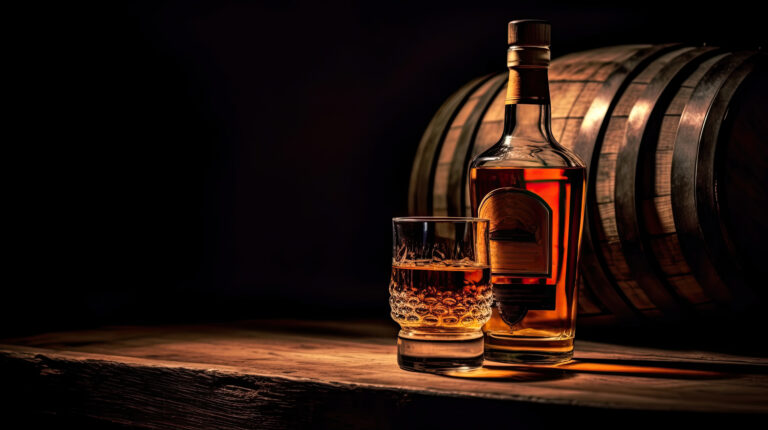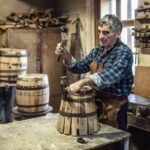Ever wondered how long it takes to age whiskey in one of those adorable little 5 liter barrels you see popping up everywhere? As a whiskey lover, you’ve probably been tempted to grab one of those barrels and try your hand at aging some whiskey at home. Before you dive in, it’s important to understand how barrel aging works and how it impacts the flavor of your whiskey. Aging whiskey is part art and part science. There are a few factors that determine how long it will take to age whiskey in a small barrel and end up with a great tasting final product. Follow along and we’ll explore how barrel size, barrel char, temperature, and evaporation all impact the aging process so you can make an informed decision about how long to age your whiskey.
Introducing Whiskey Aging in Small Barrels
Aging whiskey in 5 liter barrels allows for rapid maturation due to the increased surface area to volume ratio. The smaller the barrel, the quicker the aging process. In a short time, you can develop a wonderfully complex, smooth whiskey with notes of vanilla, caramel and oak.
How Long to Age
For a 5 liter barrel, aging between 3 to 6 months is typical for most small batch distillers. This provides enough time for the whiskey to absorb the oak flavors and develop character, while still keeping the fresh, vibrant qualities of the new spirit. Check on your barrel’s progress regularly by tasting small samples. Once it reaches a point where the oak, spice and vanilla notes are balanced and pleasant, it’s ready to bottle.
Every barrel is different though, so let your taste guide you. Don’t be afraid to bottle earlier or age longer based on the individual flavors of your whiskey. The key is tasting frequently so you can catch it at just the right moment. Aging whiskey in small barrels allows you to truly customize the end result. With some experimentation, you’ll be making memorable whiskey in no time!
The Benefits of Aging Whiskey in 5 Liter Barrels
Aging whiskey in smaller 5 liter barrels allows for more surface area contact between the spirit and the wood, which means faster aging and more complex flavors.
Accelerated Aging
In a standard 50 liter barrel, it can take 3-5 years for whiskey to develop a balanced, mature flavor. But in a 5 liter barrel, the aging process speeds up significantly. After just 6-12 months, your whiskey can take on rich notes of vanilla, spice and dried fruit from the wood.
Intensified Wood Flavors
The wood-to-whiskey ratio is much higher in smaller barrels, infusing the spirit with robust oak flavors. You’ll end up with an amber colored whiskey with distinct woody, caramel and toffee notes.
Customized Taste
Smaller barrels give you more control over the aging process. You can create a personalized whiskey to suit your tastes by aging for a shorter or longer period. Check on your barrel regularly and bottle when it reaches your desired color and aroma.
With some patience and experimentation, a 5 liter barrel can produce an amazing custom whiskey. The benefits of accelerated aging, intensified wood flavors and a customized spirit are well worth the investment for any whiskey enthusiast.
How Oak Barrel Size Impacts Whiskey Aging
The size of the oak barrel used to age whiskey has a significant impact on how quickly it matures and develops flavor.
Smaller Barrels
A 5 liter barrel has a higher surface area to volume ratio, so more of the whiskey is exposed to the wood. This means faster extraction of flavors like vanilla, caramel and oak. However, this also means the whiskey can become over-oaked more quickly. For the best results, age whiskey in a small barrel for just 3 to 6 months. This short aging period will impart nice oak flavors without becoming too woody.
Larger Barrels
In contrast, whiskey aged in a larger 53 gallon barrel may need 3 years or more to develop a similar oak influence. While aging takes longer, the slower interaction with the wood results in a smokey, spicy flavor. The larger barrel also allows more subtle flavor compounds to develop over time.
In the end, the barrel size you choose depends on how quickly you want to age your whiskey and the flavor profile you’re after. Both small and large barrels can produce great results, you just need to monitor the aging process closely to achieve the perfect oak balance.
Estimating the Ideal Aging Time for 5 Liter Barrels
When aging whiskey in small 5 liter barrels, patience is key. Because of the increased surface area to volume ratio, the whiskey will pick up oak flavors much faster. Expect the whiskey to mature 3-5 times quicker than a standard barrel.
Checking on your barrel’s progress regularly is important. After just 3-6 months, the whiskey can become over-oaked and take on a bitter taste. Start sampling after 2 months to determine if it has reached peak flavor for your tastes. You want to pull it at the point when the oak flavors balance nicely with the original whiskey character.
As a general rule of thumb, aim for 3 to 12 months for most small barrel aging. Bourbon and other sweeter whiskeys tend to age faster, around 3 to 6 months, while some single malts may go 6-12 months. But remember, it depends on the specific whiskey and your personal flavor preferences.
The only way to know for sure if your whiskey has reached its prime is to taste it. When the oak, vanilla and caramel notes blend harmoniously with the base spirit and it has a nice balance of smoothness and complexity, it’s probably time to bottle. But if at any point it starts to taste harsh or bitter, it’s best to pull it immediately.
Aging whiskey in small barrels allows you to create a unique, custom product tailored to your tastes. Keep a close eye on your barrel and you’ll be sipping a one-of-a-kind whiskey in no time!
Tasting and Testing Your Whiskey Over Time
Once your whiskey has aged for at least 6-12 months, it’s time to start tasting it to determine if it’s ready or needs more time. As the whiskey ages, its flavor will change dramatically.
Initial Tasting
Pour a small amount of your whiskey into a glass and observe its color and aroma. Take a small sip and notice the flavors—you’ll likely detect strong notes of oak, caramel, and spice. The alcohol burn may still be quite harsh at this point. If it tastes overly woody or harsh, it probably needs more aging.
3 Months Later
Try another tasting 3 months later. The color should be noticeably darker and the aroma more complex. The oak and spice notes will have mellowed, giving way to flavors like vanilla, nuts, and dried fruit. The alcohol burn will have smoothed out considerably. If it tastes balanced and pleasant, it may be ready to bottle. If still a bit rough, keep aging.
Continued Aging
Keep tasting your whiskey every 3-6 months to monitor how the flavor develops and when it peaks based on your tastes. The whiskey may age for 2-5 years total before it reaches maximum quality. Be very careful not to over-age the whiskey, or it can become overly oaky. Once you’re satisfied with the flavor, you can bottle and enjoy your homemade aged whiskey! The aging and tasting process is key to crafting a whiskey you’ll love.
How Other Factors Like Climate Influence Aging Time
The climate where you store your whiskey barrel has a big impact on how long it needs to age. Warmer temperatures speed up chemical reactions in the barrel, causing the whiskey to extract more flavor from the wood in less time.
Temperature
If you age your barrel in a warmer area like a garage or shed, the whiskey can pick up oaky flavors much faster. You may only need 6-12 months for a robust, woody character. Colder temperatures, like in a basement, will require at least double that time for the same effect. The ideal range is between 55 to 65 F.
Humidity
The amount of moisture in the air also plays a role. More humidity means the barrel staves will swell, allowing the whiskey to penetrate the wood more deeply. The whiskey will also evaporate more slowly, resulting in a higher yield. Drier conditions can speed up evaporation and slow the infusion of oak flavors. Moderate humidity around 65% is best.
Ventilation
Allowing some airflow around the barrel is important for temperature and humidity control. Stagnant, non-ventilated areas may lead to mold growth. But too much direct airflow can cause excess evaporation. Find an area with decent ventilation that still provides stable temperature and humidity.
In the end, the aging time for your 5 liter barrel comes down to personal taste. But providing the ideal climate conditions will help ensure you achieve the flavor profile you’re looking for, whether it’s 6 months or 2+ years. Paying close attention to these environmental factors will allow you to better predict how long to age your whiskey.
Signs Your Whiskey Is Ready After Aging in a 5 Liter Barrel
After months or years of patiently waiting, how do you know when your whiskey has reached perfection in the barrel? Here are a few signs your spirit may be ready for bottling.
The whiskey has taken on an amber color. As it ages, the whiskey interacts with the wood of the barrel, extracting compounds that darken the color from clear to a rich amber brown. The longer it ages, the darker it becomes.
The aroma has notes of vanilla, caramel or oak. The oak barrel imparts a sweet, woody aroma to the whiskey. You may detect scents of vanilla, caramel, cocoa or toasted nuts. These aromas intensify over time.
The flavor is smooth and mellow. Freshly distilled whiskey can taste harsh and spirity. With age, the flavor mellows and becomes smoother. Flavors of dried fruit, spice and wood emerge.
The whiskey has reached your desired flavor. Ultimately, taste is subjective. When your whiskey has achieved a flavor you enjoy, whether subtly woody or rich and complex, it may be time to bottle. You can sample your whiskey periodically using a tasting valve to monitor how the flavor develops.
While aging whiskey longer often results in a finer spirit, at some point the barrel effects and flavor compounds start to break down. Most craft distillers recommend aging whiskey 3 to 5 years in a 5 liter barrel. But let your taste be the guide—your whiskey is ready when you say it’s ready!
Tips for Maximizing Flavor During Short Aging Periods
Use Smaller Barrels
For shorter aging periods, use smaller barrels. The smaller the barrel, the more wood surface area is exposed to the whiskey. This allows for faster infusion of wood flavors like vanilla, caramel and oak. A 5 liter barrel is a great size for home aging and allows you to achieve good results in 3-6 months.
Higher Proof Spirit
Start with a high proof spirit, around 120 proof or 60% ABV. The higher alcohol content will pull more flavor compounds from the wood. You can always water it down to your desired strength before bottling.
Age in a Warm Area
Keep your aging barrel in a spot with stable, warm temperature. Attics, garages and basements are ideal. The heat will cause the wood to expand, allowing the whiskey to penetrate deeper into the wood. Warmth also speeds up chemical reactions that create aromas and flavors.
Rotate and Sample
Rotate and turn your barrel every few weeks to maximize wood contact. And be sure to sample your whiskey along the way using the spigot or by drawing a small amount from the bung hole. This allows you to track how the flavor develops and decide when it’s to your liking. You can then bottle, or continue aging if desired.
Add Wood Staves
For extra wood influence in a shorter time, add 2-3 charred oak staves to the barrel. The staves provide more surface area for the whiskey to interact with. Taste regularly and remove the staves when the wood flavors become intense.
Patience is Still Required
While small barrels speed up aging, patience is still needed. A good rule of thumb is at least 3 months for decent results, but 6-12 months will provide a more balanced, oaky character. Resist the urge to bottle too early, and your patience will be rewarded.
How Long to Age Whiskey in 5 Liter Barrel FAQs
Aging whiskey in a small 5 liter barrel allows for rapid maturation, but how long should you age your whiskey? Here are some tips to keep in mind:
3 to 6 months
For a light, floral whiskey with hints of the barrel, 3 to 6 months is a good start. This will give you an introduction to aging whiskey without an overpowering oak flavor. Check on your barrel regularly and taste the whiskey to get it where you want.
6 months to 1 year
At 6 months to a year, the whiskey will pick up more caramel and vanilla notes from the barrel. The heat and surface area to volume ratio of a small barrel means the whiskey is exposed to more wood, accelerating the aging process. Be very careful not to over oak the whiskey.
1 to 2 years
Aging 1 to 2 years will result in a whiskey with rich oak, caramel and spice flavors. The whiskey may become quite dark. Only age this long if you want an intensely woody, robust whiskey.
Longer than 2 years
While possible, aging longer than 2 years in a 5 liter barrel risks over-oaking the whiskey to the point of bitterness. The smaller the barrel, the less time needed. Unless you want an extremely oak-forward whiskey, stick to 2 years or under.
The exact time will depend on personal taste and the characteristics you want in your aged whiskey. Start with a shorter time period, then check on your barrel regularly by tasting the whiskey. Once it reaches a point you enjoy, bottle it up! The key is not to leave it too long, or you may end up with an overly woody whiskey.
Final Thoughts
You’ve now got the basics down for aging whiskey in a small barrel. The aging time will vary depending on the type of whiskey and your personal taste preferences. Start checking on your barrel at around 3 months to see how the flavor is developing. Once you’re happy with the taste, you can bottle it up and enjoy the fruits of your labor. Home aging whiskey is a fun and rewarding hobby. You’ll be able to create custom blends to share with friends or save for special occasions. If after your first batch you catch the whiskey aging bug, you might just find yourself looking to expand into larger barrels to keep up with demand from family and friends who want a taste of your homemade, handcrafted whiskey.







